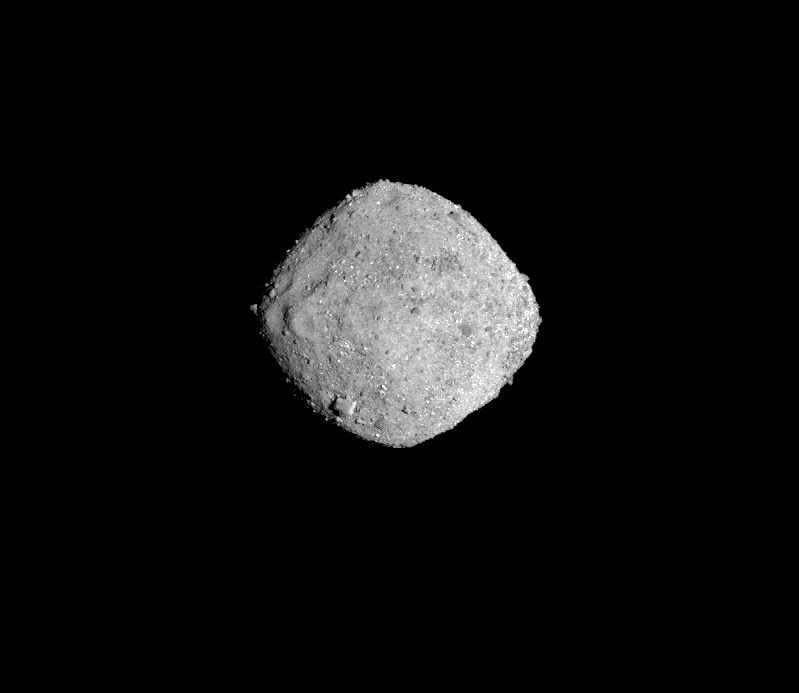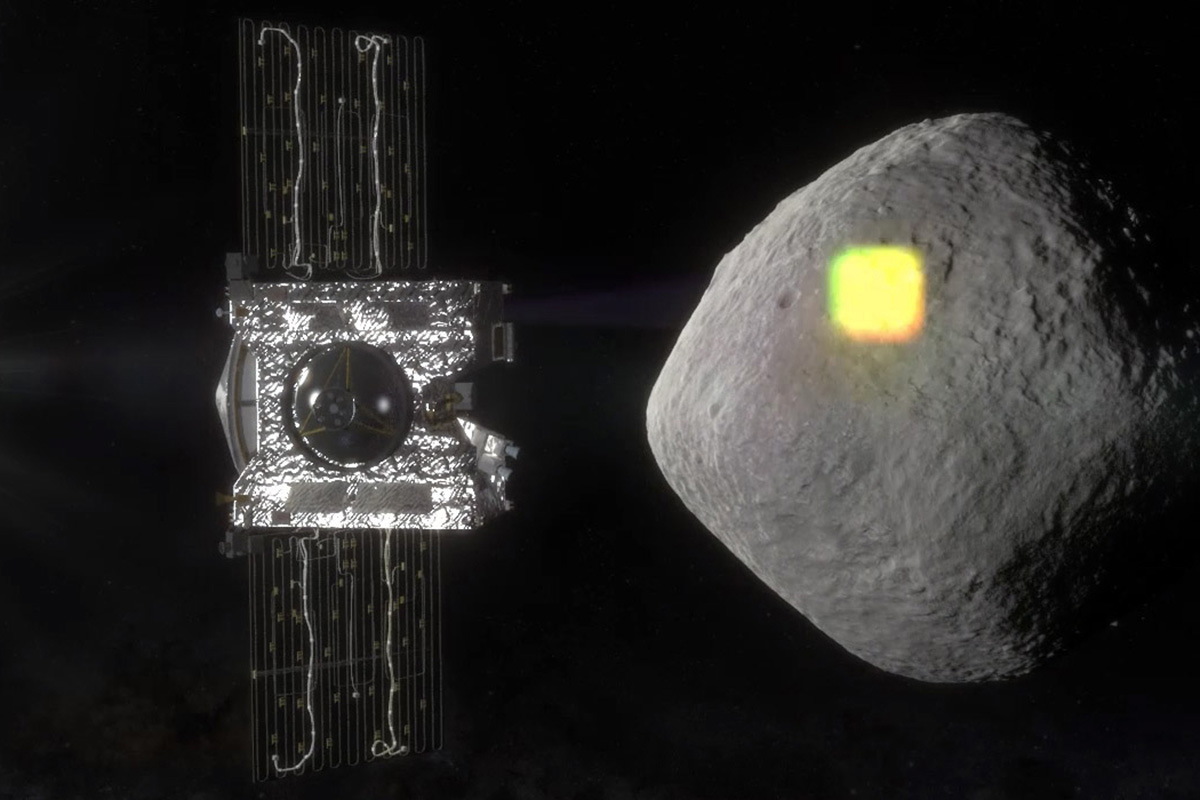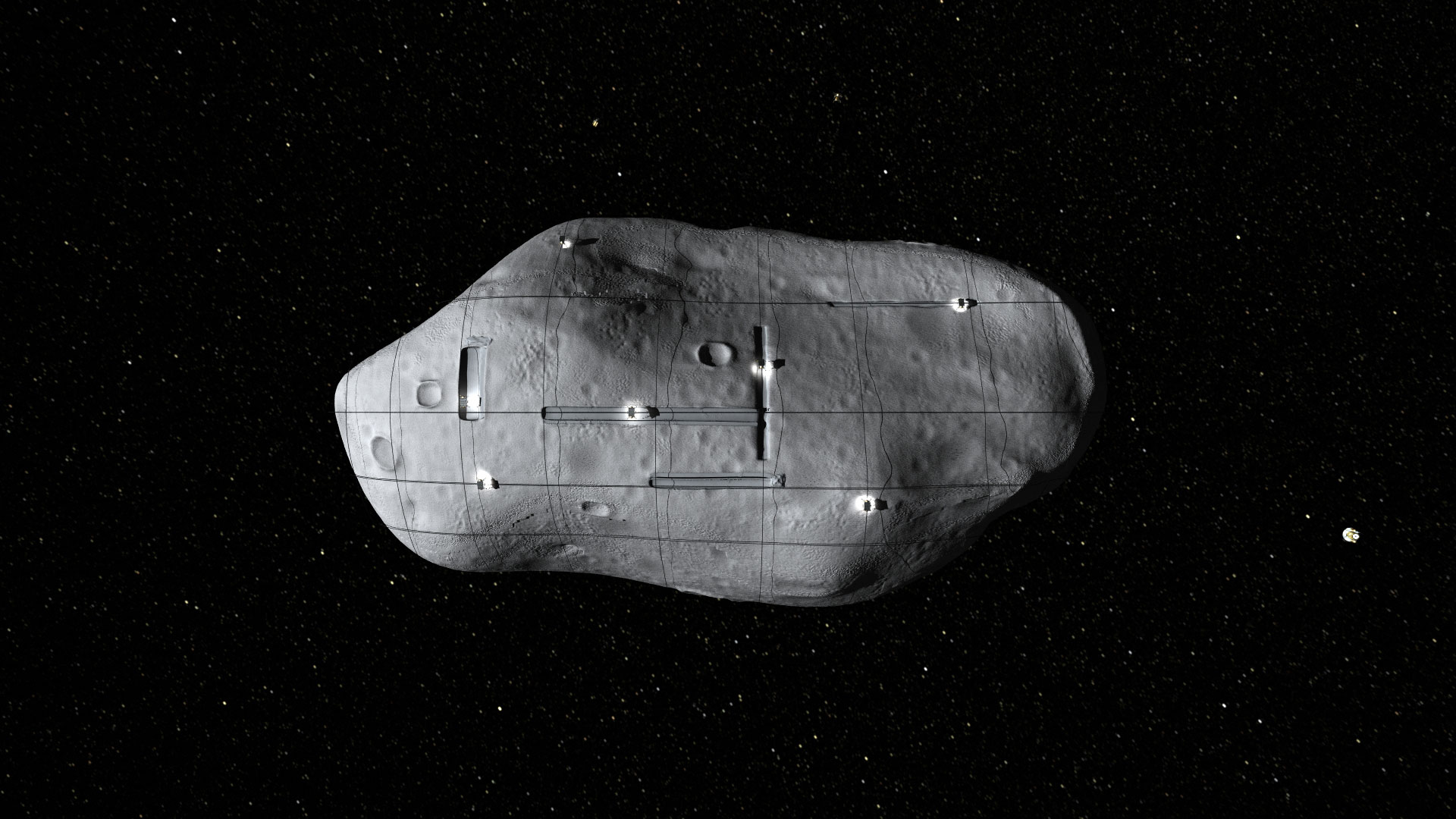NASA's OSIRIS-REx spacecraft sidled up to the diamond-shaped asteroid Bennu today (Dec. 3) at about 12 p.m. EST (1700 GMT), wrapping up a circuitous cosmic chase that lasted 27 months.
"Achievement unlocked: 'We have arrived!'" NASA officials said via Twitter today. [OSIRIS-REx: NASA's Asteroid Sample-Return Mission in Pictures]
OSIRIS-REx is now less than 12 miles (20 km) from Bennu, but the probe is flying along with the space rock rather than orbiting it. Orbital insertion won't come until Dec. 31, after OSIRIS-REx has performed a series of flybys that will bring the probe to within just 4.3 miles (7 km) or so of Bennu's boulder-strewn surface.
During these close encounters, OSIRIS-REx will study Bennu in depth, allowing team members to nail down the 1,650-foot-wide (500 meters) asteroid's mass and precise shape.
"It's really important for us to spend some time gathering that data and making sure that the assumptions we have going into orbit are correct, to reduce the risk of having an inaccurate insertion," OSIRIS-REx Deputy Principal Investigator Heather Enos, of the University of Arizona, told Space.com.
That orbital insertion will be another groundbreaking moment. For starters, no spacecraft has ever circled an object as small as Bennu. And OSIRIS-REx will get very close, slipping into an orbit just 1 mile (1.6 km) above the space rock on Dec. 31.
"We're going to set a record for the closest distance that a spacecraft ever orbited a small body," Enos said. "So, we don't take that lightly, and we do need to do things methodically."
Get the world’s most fascinating discoveries delivered straight to your inbox.
Orbital insertion, by the way, will occur just one day before NASA's New Horizons probe makes its epic flyby of the frigid, faraway object Ultima Thule. (Happy New Year!)
A long haul
The $800 million OSIRIS-REx mission launched on Sept. 8, 2016, then returned for a speed-boosting "gravity assist" flyby of Earth almost exactly one year later. The probe has been closing the gap on Bennu ever since, during a space chase covering more than 1.25 billion miles (2.03 billion km).
OSIRIS-REx will collect a variety of scientific data over the coming months. But the spacecraft will also do quite a bit of scouting work, looking for the best place for swoop down and snag at least 2.1 ounces (60 grams) of Bennu material.
This sample-collection maneuver is scheduled to occur in July 2020. If all goes according to plan, OSIRIS-REx will depart Bennu in March 2021, and the sample will come down to Earth in a special return capsule in September 2023.
The Bennu bits will be the largest celestial sample brought to Earth by a space mission since the Apollo era, when NASA astronauts lugged hundreds of pounds of moon rocks back to their home planet.
Researchers in labs around the globe will then scrutinize the material, searching for clues about the early history of the solar system, and the role that carbon-rich asteroids such as Bennu may have played in helping life get started on Earth long ago (by delivering water and organic chemicals, the building blocks of life as we know it).
And there's no telling what other discoveries may come from such sample study, mission team members have said.
Sample return "is the gift that keeps on giving," Enos said. Scientists are still poring over the Apollo rocks, more than 45 years after the last of them came to Earth, she noted. [Lunar Legacy: 45 Apollo Moon Mission Photos]
"We just keep improving our analytical skills to take things to the subatomic level and really dissect them, so to speak," Enos said.
Many mission goals
OSIRIS-REx has many subsidiary goals in addition to the main objective outlined above. Such diversity and ambition are apparent in the mission's full name: "Origins, Spectral Interpretation, Resource Identification, Security-Regolith Explorer."
For example, OSIRIS-REx's data should shed light on the resource potential of Bennu-like asteroids, providing data of interest to space miners and the human-spaceflight community, mission team members have said. (NASA officials and exploration advocates have stressed the importance of exploiting in-space resources, such as water ice, for humanity's sustained expansion out into the solar system.)
And then there's the "security" component. OSIRIS-REx's measurements at Bennu should help scientists better understand how solar heating — or, more precisely, the asymmetrical emission of absorbed solar radiation — can affect asteroids' paths through space. Such information could lead to more-accurate predictions of where potentially hazardous space rocks may be headed, OSIRIS-REx team members have said.
Bennu itself falls into this category: There's a very slight chance that the space rock could slam into our planet in the late 22nd century.
Asteroids are fascinating for lots of reasons. They contain a variety of valuable resources and slam into our planet on a regular basis, occasionally snuffing out most of Earth's lifeforms. How much do you know about space rocks?
Asteroid Basics: A Space Rock Quiz
Working together
OSIRIS-REx, which was built by aerospace company Lockheed Martin, isn't the only spacecraft exploring a near-Earth asteroid right now. Japan's Hayabusa2 spacecraft has been orbiting the 3,000-foot-wide (900 m) space rock Ryugu — which shares Bennu's diamond shape — since June and has even dropped a handful of miniprobes onto the asteroid's surface.
Hayabusa2 is also a sample-return mission; the probe's return capsule is scheduled to come down to Earth in December 2020.
The OSIRIS-REx and Hayabusa2 teams have already been working together, and the collaboration will continue through sample collection, return and analysis. NASA and the Japan Aerospace Exploration Agency have agreed to share samples with each other, Enos said.
"I think that we're really lucky in the science community and the planetary-exploration community to have two missions going on at the same time," she said.
"And although we have a lot of similarities with Hayabusa2, our asteroids are considered to be a very different composition," Enos added. "That in itself is really puzzling and will be exciting to explore."
Mike Wall's book about the search for alien life, "Out There" (Grand Central Publishing, 2018; illustrated by Karl Tate) is out now. Follow him on Twitter @michaeldwall. Follow us @Spacedotcom or Facebook. Originally published on Space.com.







